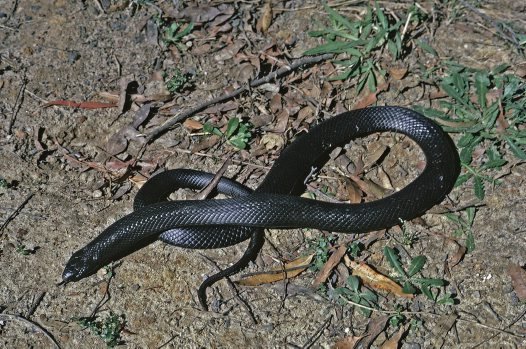Blue-bellied Black Snake
Spotted Black Snake
In areas where Blue-bellied Black Snakes are found they are often confused with the similar-looking Red-bellied Black Snake Pseudechis porphyriacus, and also occasionally with the Eastern Brown Snake Pseudonaja textilis (particularly brownish specimens). Juvenile snakes may also resemble dark or melanotic forms of Swamp Snake Hemiaspis signata, although they will lack the white facial stripes that are usually present in this species.
Introduction
Despite its size and relative abundance, not much is known of the habits of this handsome “poor cousin” of the Red-bellied Black Snake.
Identification
Blue-bellied Black Snakes are predominantly a shiny bluish- or brownish-black, with a dark bluish-grey or black belly. Some individuals can be cream/pale grey in colour, with each scale edged in black, giving a spotted appearance (hence their other common name Spotted Black Snake). Others may be intermediate between the two, having a mixture of pale and dark scales that form thin broken crossbands, however in all forms the head is uniformly dark.
The head is relatively broad and deep, and barely distinct from the robust body. There is an obvious brow ridge over the darkly-coloured eye.
Midbody scales 19 rows, ventral scales 175-205, anal scale divided, subcaudals single anteriorly, divided posteriorly.

Blue-bellied Black snake, Pseudonaja guttata
Image: Hal Coggar© Hal Coggar
Habitat
The Blue-bellied Black Snake can be found in a range of habitats, from river floodplains and wetlands to dry sclerophyll forest and woodlands. They shelter under fallen logs, in deep soil cracks or abandoned animal burrows, and also in dense matted vegetation.
Distribution
The snake occurs just west of the coastal ranges in southeast Queensland and northeastern New South Wales.
Feeding and diet
In the wild, the species eats a variety of vertebrates including frogs, lizards, snakes and mammals. It also eats the occasional invertebrate. Blue-bellied Black Snakes are primarily diurnal hunters; however they will forage late on warm evenings.
Breeding behaviours
Male combat and mating has been recorded in wild Pseudechis guttatus occurring in the period between late winter and early spring (late August-early October). Combat appears to involve initial biting, followed by intertwining, and then pursuit with more biting. Gravid females have been observed in the wild in late winter-early spring (5 September-October).
In captivity, mating snakes coil loosely together with their tails wrapped around each other. The male occasionally moves his head back and forth along the female's body during copulation, which may last up to five hours. After a successful mating, the male shows no further interest in the female. Gravid females will usually refuse food in the period between mating and egg-laying.
Between 5 and 17 eggs are laid which may take up to 87 days to hatch, depending on the incubation temperature. The young remain in their egg for one or two days after slitting the egg case before emerging to begin their independent lives.
Conservation status
Not listed as threatened.
Danger to humans
Usually a shy animal, the Blue-bellied Black Snake will defend itself aggressively if threatened. It will first give a warning display, hissing loudly and holding its flattened forebody in a low S-shape. Further harassment will cause the snake to strike out, although it sometimes does so with a closed mouth. If the snake does bite it often hangs on and chews, ensuring a good dose of venom is injected. The venom is highly toxic and contains coagulants, haemolysins, neurotoxins and cytotoxins. Anyone suspected of receiving a bite from a Blue-bellied Black Snake should seek immediate medical attention.
- If bitten call emergency services: Mobile phone: 112 Landline: 000
- Apply pressure-immobilisation bandage over the injury and along the limb or affected area to prevent the venom from spreading throughout the body:
- Wind the bandage around the bitten arm or leg, starting from the bite.
- The bandage should not be so tight that it restricts blood flow.
- Wrap the entire limb, then apply a splint to prevent movement.
- Keep the victim as still as possible.
- Do not remove the bandage.
Seek medical attention as soon as possible.
First aid guidelines were correct at time of publication however these guidelines change over time. For up to date first aid information consult medical professionals such as St John's Ambulance.
References
Cogger, H. (2000) “Reptiles and Amphibians of Australia”, Reed New Holland
Greer, A.E. (2006) “Encyclopedia of Australian Reptiles : Elapidae”, Australian Museum
Ehmann, H. (1992) “Encyclopedia of Australian Animals : Reptiles”, Australian Museum, Angus & Robertson
Mirtshin, P. and Davis, R. (1991) “Dangerous Snakes of Australia”, revised edition, Ure Smith Press
Wilson, S. and Swan, G. (2008) “A Complete Guide to Reptiles of Australia”, Reed New Holland


